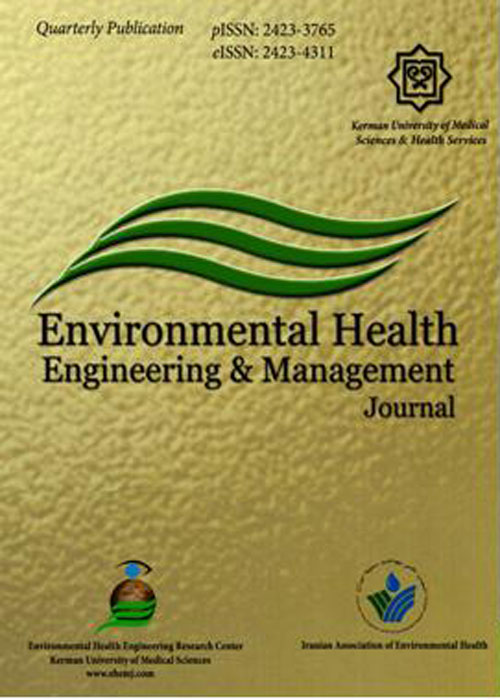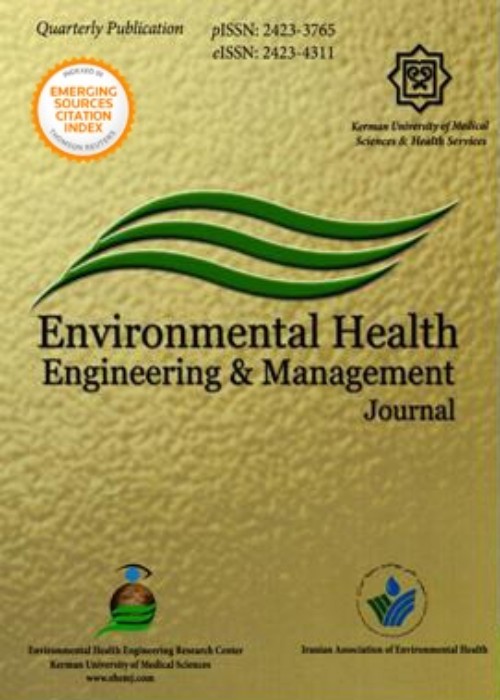فهرست مطالب

Environmental Health Engineering and Management Journal
Volume:3 Issue: 1, Winter 2016
- تاریخ انتشار: 1395/01/31
- تعداد عناوین: 8
-
-
Pages 1-7BackgroundThe efficacy of NH4Cl-induced activated carbon (NAC) was examined in order to adsorb RR198, an azo reactive model dye, from an aqueous solution.MethodsThe effects of pH (3 to 10), adsorbent dose (0.1 to 1.2 g/L), dye concentration and contact time on the adsorption efficiency were investigated.ResultsThe results showed that the removal of dye was highest at a solution pH of 7 and a powder dose of 1.1 g/L. The 85.9%, 72.6% and 65.4% removal of RR198 was obtained for a concentration of 25, 50 and 100 mg/L, respectively, at a relatively short contact time of 30 minutes, and at optimum pH and NAC concentrations of 1 g/L. The experimental data for kinetic analysis illustrated a best fit to the pseudo-second-order model. The study data on equilibrium were modeled using Langmuir, Freundlich and DubininRadushkevich models; the Langmuir equation provided the best fit for the data.ConclusionTherefore, the NAC appears to be an efficient and appropriate adsorbent for the removal of reactive azo dyes from waste streams.Keywords: Azo dye, Adsorption, Modified activated carbon, Equilibrium, Isotherm, Kinetic
-
Pages 9-14BackgroundEstrogens include estoril (E3), estradiol and estrone (E1). These chemicals are produced in human and animal bodies as well as in synthetic chemicals (drugs). Estrogens can enter water sources in different ways. When these chemicals enter the human body through water and wastewater, they have the ability to mimic or disrupt the normal estrogen activities in humans and animals. Estrogens in wastewater are able to pass soil layers and contaminate groundwater. Therefore, in this study, the removal of the hormone 17ß-estradiol (E2) as a representative of estrogens in three types of soils was studied. The selection was chosen in respect to the importance of entering the hormone into groundwater through the soil.MethodsThis study was an experimental study in which the removal of the hormone E2 from different depths of three types of soils was experimented. The soils were consisted of two different textures, the silty sandy clay and the silty sand with gravel. The hormone E2 was diluted and injected into the drilled holes. Soils were characterized in the soil mechanics laboratory. Hormone extraction from the soils was performed using a centrifuge and analyzed with the Elecsys device. The results were analyzed using the IBM SPSS version 22 software.ResultsThe results showed that the removal rates of hormone E2 in the three types of soils were higher than 99.5%, and the removal rate in the silty sand was more than the others. In all three soil samples, the removal rates in the first layer were high. The average injected hormone in the soil decreased from 3500 to 3112 ng/l. The results showed that the adhesion and plasticity of the soil had also affected the removal rates.ConclusionResults showed that the soil plays a significant role in the removal of E2 hormone and this hormone was reduced or eliminated in the first layers of the soils. Thus, the risk of groundwater contamination is low.Keywords: Estrogen, 17ß, estradiol hormone, Silty sandy clay, Silty sand with gravel
-
Pages 15-21BackgroundLead (Pb) is a heavy metal that is widely utilized in industries. It contaminates soil and groundwater. Its non-biodegradability, severe toxicity, carcinogenicity, ability to accumulate in nature and contaminate groundwater and surface water make this toxic heavy metal extremely dangerous to living beings and the environment. Therefore, technical and economic methods of removing Pb are of great importance. This study evaluated the efficiency of Ni0.5Zn0.5Fe2O4 magnetic nanoparticles supported by Aloe vera shell ash in removing Pb from aqueous environments.MethodsThe adsorbent was characterized by several methods, including x-ray diffraction (XRD), scanning electron microscopy (SEM), and Fourier transform infrared spectroscopy (FT-IR). Then, the potential of Aloe vera shell ash-supported Ni0.5Zn0.5Fe2O4 magnetic nanoparticles to adsorb Pb (II) was investigated. To determine the amount of lead absorbed by this adsorbent, different pHs (2, 4, 5, and 6), adsorbent doses (0.01-0.40 g), Pb concentrations (5, 10, 20, 30, 40, 50, 60, 80, 100, 200, 300, and 600 mg/L), and exposure times (0, 5, 10, 15, 20, 30, 40, 50, and 60 minutes until reaching equilibrium) were tested using an atomic absorption spectrometer (Varian-AA240FS). Residual concentrations of Pb were read.ResultsThe results show that a time of 15 minutes, pH value of 9, and adsorbent dose of 0.2 g are the optimum conditions for Pb (II) removal by this adsorption process. Increasing the initial concentration of Pb (II) from 5 to 600 mg/L decreased removal efficiency from 98.8% to 73%. The experimental data fit well into the Freundlich isotherm model (R2 = 0.989).ConclusionNi0.5Zn0.5Fe2O4 magnetic nanoparticles supported by Aloe vera shell ash comprise a low-cost, simple, and environmentally benign procedure. The maximum monolayer adsorption capacity based on the Langmuir isotherm (R2 = 0.884) is 47.2 mg g-1. The prepared magnetic adsorbent can be well dispersed in aqueous solutions and easily separated from them with the aid of an external magnet after adsorption. The process for purifying water presented here is clean and safe. Therefore, this adsorbent is applicable to managing water pollution caused by Pb (II) ions.Keywords: Adsorption, Pb (II) ions, Ni0.5Zn0.5Fe2O4, Aloe vera, Aqueous solutions
-
Pages 23-28BackgroundUrmia Lake, the second largest hyper-saline lake of the world, has experienced lack of water and other environmental issues in recent years. Now, there is a danger of the lake drying out, which will affect the region and its inhabitants. This study aimed to present a model which can relate the water level of the lake to effective factors.MethodsParameters that influence water level, such as precipitation, evaporation, water behind dams, and the previous years water level, were considered in the modeling procedure. The proposed model, based on evolutionary polynomial regression, can be used to evaluate salt marshes produced in the region in recent years.ResultsResults show that the high surface-area-to-depth ratio of Urmia Lake is most influential on its drying; however, omitting this characteristic as an inherent one, the main cause is the construction of dams on rivers in the Urmia Lake basin.ConclusionThe proposed model predicts that by 2015, the water level of Urmia Lake will fall below 1269 m, and by 2030, the lake will dry out completely.Keywords: Urmia Lake, Water level, Air pollution, Health impacts
-
Pages 29-34BackgroundMicroalgal lipid is a promising feedstock for biodiesel production. The aim of the present study was to investigate the effects of cultivation temperature on the growth and lipid accumulation properties of Nannochloropsis oculata microalgae.MethodsNannochloropsis oculatacan grow in a wide range of temperatures (5 ~ 35°C). Late in the stationary growth phase of microalgae, biomass production and lipid accumulation were measured. The methanol-chloroform extraction method was used to extract total lipids from dried cells. The direct esterification method was used to measure fatty acids. Constituents were identified by gas chromatography.ResultsThe results show that the maximum specific growth rate at 20°C was 0.1569 day-1, and the maximum biomass production of microalgae at 25°C was 2.2667 g/L. The highest percentage of biomass conversion into lipid (35.71%) occurred at 30°C. Maximum lipid productivity was seen at temperatures of 15°C, 20°C, and 25°C, but the analysis of fatty acids in the three temperatures shownare maximum accumulations of triglycerides in the microalgae cells at 20°C and 25°C.ConclusionIn the cultivation of Nannochloropsis oculata, the optimal temperature range for maximum efficiency in biodiesel production from lipids is 20°C to 25°C.Keywords: Freshwater microalga, Nannochloropsis oculata, Cultivation temperature, Lipid accumulation
-
Pages 35-40BackgroundMature landfill leachate is a complicated mixture which is resistant to biological treatment processes. The treatment of mature landfill leachate by struvite precipitation and Fenton oxidation was the main objective of the current research.MethodsStruvite with the phosphate/ammonia/magnesium molar ratio of 1/1/1.05 was considered during all experiments. Five initial pHs of 3, 4, 5, 6, and 7, four different H2O2/Fe mass ratios of 50, 100, 200, and 400, and reaction times of 20, 40, 80, 120, and 160 minutes were examined for the Fenton oxidation process.ResultsA leachate sample with average chemical oxygen demand (COD), BOD5, and NH4 concentrations of 7350, 2220, and 2280 mg L-1, respectively, and a BOD5/COD ratio of 0.3 was introduced to the chemical precipitation unit. An NH4 removal efficiency of 87% was obtained at pH 8.5 for struvite precipitation. Under optimum conditions of Fenton oxidation, including pH 3, an H2O2/Fe2 mass ratio of 200, and a reaction time of 160 min, more than 95% COD and BOD5 removal was observed.ConclusionStruvite precipitation and Fenton oxidation are reliable and efficient alternatives for mature landfill treatment.Keywords: Landfill, Leachate, Fenton oxidation, Chemical precipitation, Advanced oxidation
-
Pages 41-46BackgroundPhenol is an organic pollutant found in industrial effluents that is very toxic to humans and the environment. This study used pomegranate peel ash as a natural absorbent to remove phenol from aqueous solutions.MethodsIn this study, pomegranate peel ash in different doses was used as a new adsorbent for the removal of phenol. The effects of contact time, pH, adsorbent dose and initial phenol concentration were recorded. Then, the adsorption data was described with Langmuir and Freundlich adsorption isotherms; Excel software was used for data analysis.ResultsThe highest percentage of phenol adsorption was observed at pH = 7. The optimum amount of adsorbent was 0.6 g/l, and after 120 minutes, the process reached an equilibrium state. The adsorption of phenol decreased following an increase in the pH of the solution. It was also observed that contact time significantly affected the rate of phenol adsorption. The experimental data fit much better in the Freundlich (R2 = 0.9056) model than in the Langmuir (R2 = 0.8674) model.ConclusionPomegranate peel ash has the potential to be utilized for the cost-effective removal of phenol from aqueous solutions.Keywords: Phenol removal, Pomegranate peel ash, Aqueous solution
-
Pages 47-53BackgroundThe presence of heavy metals in aquatic and terrestrial ecosystems causes harmful effects to living organisms in the environment. This research aimed to determine the potential of activated pumice stone (APS) as a sorbent for the removal of Cd, Cu, and Zn from wastewater.MethodsThis research was conducted during 2013 on a laboratory scale. The study was performed using batch experiments with synthetic wastewater having Cd, Cu, and Zn concentrations of 10, 20, 40, and 80 mg/L. Various isotherm models, including Langmuir and Freundlich, were used to evaluate the sorption data. The influence of contact time and amount of sorbent on the removal of Cd, Cu, and Zn from wastewater was studied. All experiments were done at pH = 7 and at room temperature (20 ± 1°C). The solution pH was adjusted using 1N NaOH or 1N HCl solutions, and the pH value was determined by a pH meter.ResultsThe results showed that the adsorption of Cd, Cu, and Zn approaches equilibrium after about 2 hours, while the rates of removal efficiency for Cd, Cu, and Zn at equilibrium were 91.6%, 91.8%, and 82.9%, respectively. Kinetic studies showed that the sorption of Cd, Cu, and Zn onto APS were fitted to the pseudo-second order kinetic models.ConclusionThe results indicate that the APS is a good choice, because it is a low-cost and effective sorbent. The sorption capacity of APS as a sorbent was considerably affected by the initial concentration of metal ions in the solution and by contact time.Keywords: Adsorption, Aqueous solution, Environment, Heavy metals, Pumice


